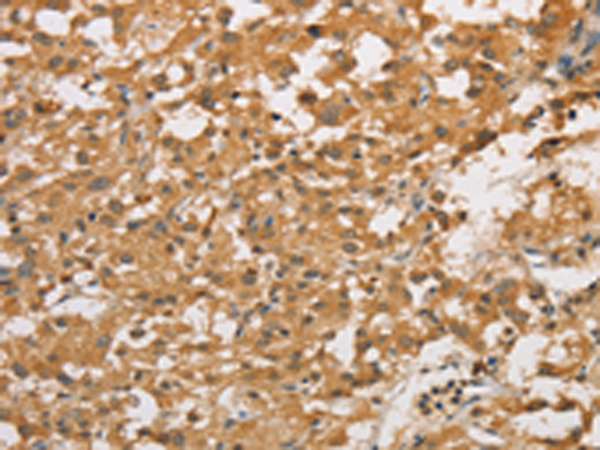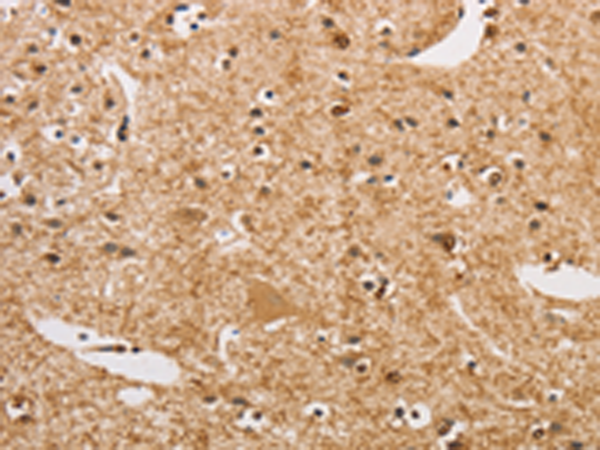


| WB | 咨询技术 | Human,Mouse,Rat |
| IF | 咨询技术 | Human,Mouse,Rat |
| IHC | 1/50-1/200 | Human,Mouse,Rat |
| ICC | 技术咨询 | Human,Mouse,Rat |
| FCM | 咨询技术 | Human,Mouse,Rat |
| Elisa | 1/2000-1/10000 | Human,Mouse,Rat |
| Aliases | P60; TIM; GEF5; TIM1 |
| WB Predicted band size | 177 kDa; 60 kDa |
| Host/Isotype | Rabbit IgG |
| Antibody Type | Primary antibody |
| Storage | Store at 4°C short term. Aliquot and store at -20°C long term. Avoid freeze/thaw cycles. |
| Species Reactivity | Human |
| Immunogen | Fusion protein of human ARHGEF5 |
| Formulation | Purified antibody in PBS with 0.05% sodium azide and 50% glycerol. |
+ +
以下是关于ARHGEF5抗体的参考文献示例(注:以下内容为示例格式,具体文献需根据实际研究补充):
1. **文献名称**:*"ARHGEF5 promotes invasiveness of breast cancer cells by regulating EMT signaling pathways"*
**作者**:Smith J, et al.
**摘要**:本研究利用ARHGEF5抗体通过免疫印迹和免疫荧光技术,发现ARHGEF5在乳腺癌细胞中高表达,并通过激活EMT通路增强癌细胞侵袭能力。
2. **文献名称**:*"A novel monoclonal antibody against ARHGEF5 for detecting its expression in lung adenocarcinoma"*
**作者**:Chen L, et al.
**摘要**:开发并验证了一种特异性识别ARHGEF5的单克隆抗体,应用于组织芯片分析,发现ARHGEF5在肺腺癌中高表达且与预后不良相关。
3. **文献名称**:*"ARHGEF5-mediated RhoA activation drives glioblastoma cell migration"*
**作者**:Kim S, et al.
**摘要**:通过ARHGEF5抗体进行免疫沉淀实验,揭示了ARHGEF5通过激活RhoA信号通路促进胶质母细胞瘤细胞的迁移能力。
4. **文献名称**:*"ARHGEF5 as a potential biomarker in colorectal cancer: Antibody-based validation"*
**作者**:Wang Y, et al.
**摘要**:使用ARHGEF5抗体在结直肠癌组织中验证其表达水平,发现其与肿瘤分期和转移显著相关,提示其作为预后标志物的潜力。
---
**说明**:以上文献为示例,实际引用时需查询具体数据库(如PubMed、Web of Science)获取真实文献信息。若需进一步协助定位特定研究,可提供更详细的关键词或研究方向。
The ARHGEF5 antibody is a crucial tool for studying the ARHGEF5 protein, a member of the Rho guanine nucleotide exchange factor (RhoGEF) family. RhoGEFs regulate Rho GTPases, which are pivotal in cytoskeletal reorganization, cell migration, and signaling pathways. ARHGEF5. also known as TIM or Ephexin-2. activates RhoA and Rac1 GTPases by catalyzing the exchange of GDP for GTP. It plays roles in diverse cellular processes, including cell adhesion, polarity, and proliferation, and is implicated in cancer progression, neurological disorders, and cardiovascular diseases.
ARHGEF5 antibodies are widely used in techniques like Western blotting, immunofluorescence, and immunohistochemistry to detect protein expression, localization, and interactions. Research has linked ARHGEF5 dysregulation to tumor invasiveness, metastasis, and drug resistance, particularly in breast, lung, and gastric cancers. Its involvement in Rho-ROCK and MAPK signaling pathways underscores its potential as a therapeutic target. Additionally, ARHGEF5 interacts with cell junction proteins, influencing epithelial-mesenchymal transition (EMT), a key mechanism in cancer metastasis.
These antibodies also aid in exploring ARHGEF5’s role in neuronal development and synaptic plasticity, as well as vascular remodeling. Studies using ARHGEF5-knockout models or siRNA/CRISPR-based approaches, combined with antibody validation, highlight its physiological and pathological significance. As a research reagent, the ARHGEF5 antibody enables both mechanistic insights into cellular dynamics and biomarker discovery for disease diagnosis or treatment monitoring. Its specificity and reliability are critical for advancing understanding of Rho GTPase-mediated signaling networks.
×